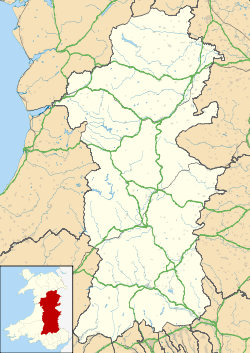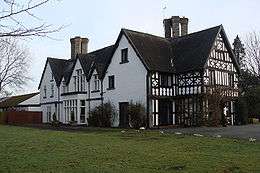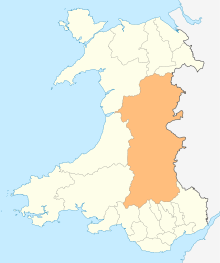Caersws
Caersws (Welsh: Caersŵs pronounced [kɑːɨrˈsuːs] (![]()
Caersws
| |
|---|---|
 The former village church | |
 Caersws Location within Powys | |
| Population | 1,586 (2011) |
| OS grid reference | SO0392 |
| Community |
|
| Principal area | |
| Ceremonial county | |
| Country | Wales |
| Sovereign state | United Kingdom |
| Post town | Caersws |
| Postcode district | SY17 |
| Dialling code | 01650 |
| Police | Dyfed-Powys |
| Fire | Mid and West Wales |
| Ambulance | Welsh |
| UK Parliament | |
The community includes the settlements of Clatter, Llanwnnog and Pontdolgoch.
Etymology
The name is derived from the Welsh placename elements "Caer-" and "Sŵs". "Caer" may be translated as "city" or "fort" and likely refers to the Roman settlement. The derivation of the second element is less certain.
Thomas Pennant and later writers note that the fort was the termination of the Roman Road from Chester (via Meifod), the name of the road was Sarn Swsan or Sarn Swsog and it is thought that the town and the road share their etymology. The meaning of Swsan/Swsog is again, uncertain, but two local traditions hold that this is a personal name, either of a Queen Swswen (a name which may translate as "The Blessed/Pure Kiss") a Celtic leader who is said to have fought a battle in the vicinity around the time of the Roman occupation, or it is named for a Roman lieutenant "Hesus".[3][4][5]
Furthurmore, the linguist John Rhys noted that the dialect of Mid-Wales Welsh (Y Bowyseg) was closer to the Gaulish language than it's neighbours, and concluded that the area had pre-Roman links to Gaul. This may suggest a link between Caersŵs and the God Esus venerated by the Parisii and Treverii.[6][7]
Other suggested etymologies include the name retaining a Roman-era dedication to Zeus, and the fact that "sws" (not sŵs) can be literally translates to "Kiss" in modern Welsh has led to a number of developing folk etymologies.
History
Caersws was the location of two Roman forts of Roman Wales. Although the Mediolanum of the Antonine Itinerary has since been identified as Whitchurch in Shropshire, Caersws is sometimes identified as the Mediolanum among the Ordovices described in Ptolemy's Geography,[8] although others argue for Llanfyllin[9] or Meifod.[9][10] Further, this second Mediolanum may be identical or distinct from the "Mediomanum" (lit. "Central Hand") mentioned by the Ravenna Cosmography.[8]
Governance
An electoral ward in the same name exists. This ward includes the community of Carno and at the 2011 Census had a population of 2,316.[11]
Buildings
Llanwnnog Church in the community of Caersws is a single-chambered structure, variously considered to date from the 13th or 15th century and restored in 1863. It contains the best example of a 15th or 16th century rood screen and loft in Montgomeryshire, a medieval font bowl and one 17th century memorial. Maesmawr Hall was built in the early 19th century.
Sport
Downhill Mountain Biking has flourished in forestry at Henblas farm, to the north of the village, with a number of national races being held there. The current series - The Caersws Cup[12] - began in March 2009.
Cymru Alliance club Caersws F.C. are based in the village, and play their home matches at the Recreation Ground.
Caersws is home to current and past champions of a number of sporting disciplines, leading some to christen it the "Sporting Capital of Wales".[13]
Notable people
- Walter Watkins, former Welsh international footballer was born here.
- Phil Woosnam, former NASL commissioner and capped Welsh footballer.
- Welsh romantic poet John Ceiriog Hughes was stationmaster and manager of the Van Railway from 1868 until his death in 1887. He is buried in the churchyard at Llanwnnog.
Gallery

 One of Caersws’ four local pubs in 2010.
One of Caersws’ four local pubs in 2010. The in town level crossing by the Caersws station in 2010.
The in town level crossing by the Caersws station in 2010. A gated village Barrow Crossing/foot crossing in Caersws in 2010.
A gated village Barrow Crossing/foot crossing in Caersws in 2010. Maesmawr Hall, a grade II* listed building
Maesmawr Hall, a grade II* listed building
See also
References
- "Parish Headcounts: Powys". Neighbourhood Statistics. Office for National Statistics. Retrieved 24 December 2012.
- "Community population 2011". Retrieved 10 November 2015.
- Eddowes, John (1832). The History of Wales; Written originally in British by Caradoc of Llancarvan; Translated into English by Dr. Powell. Shrewsbury. pp. 283–284.
- Knight, C. (1839). The Penny Cyclopædia of the Society for the Diffusion of Useful Knowledge (Volume 15 ed.). London. p. 363.
- Lewis, Samuel (1840). A Topographical Dictionary of Wales: Comprising the Several Counties, Cities, Boroughs, Corporate and Market Towns, Parishes, Chapelries, and Townships, with Historical and Statistical Descriptions (Volume 1) (2nd ed.). London.
- Williams, E. W. (30 April 2015). "J.E.Lloyd and his intellectual legacy; the tribes of Wales reconsidered" (PDF): 203. Cite journal requires
|journal=(help) - Rhys J. & Brynmor-Jones D. The Welsh People. London: Unwin. pp. 19–21.
- Roman Britain Organisation. "Mediomanum?" at Roman Britain Archived 2007-04-01 at the Wayback Machine. 2010.
- Williams, Robert. "A History of the Parish of Llanfyllin" in Collections Historical & Archaeological Relating to Montgomeryshire, Vol. III, p. 59. J. Russell Smith (London), 1870.
- Newman, John Henry & al. Lives of the English Saints: St. German, Bishop of Auxerre, Ch. X: "Britain in 429, A. D.", p. 92. Archived 2016-03-21 at the Wayback Machine James Toovey (London), 1844.
- "Ward population 2011". Retrieved 10 November 2015.
- Sporty Village Boasts Famous Five at BBC.co.uk
Literature
- Stephenson D. (2014), The Medieval Borough of Caersws: Origins and Decline, The Montgomeryshire Collections, Vol. 102, 103-109.
External links
| Wikimedia Commons has media related to Caersws. |
- 6 pages of artifacts and documents associated with Caersws and held on Gathering the Jewels the website of Welsh cultural history
- www.geograph.co.uk : photos of Caersws and surrounding area
